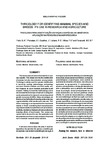Use este identificador para citar ou linkar para este item:
http://www.alice.cnptia.embrapa.br/alice/handle/doc/998134| Título: | Thricology for identifying mammal species and breeds: its use in research and agriculture. |
| Autoria: | FELIX, G. A.  PIOVEZAN, U.   QUADROS, J.   JULIANO, R. S.   ALVES, F. V.   FIORAVANTI, M. C. S.   |
| Afiliação: | GISELE APARECIDA FELIX, UFG; UBIRATAN PIOVEZAN, CPAP; UFPR; RAQUEL SOARES JULIANO, CPAP; FABIANA VILLA ALVES, CNPGC; UFG. |
| Ano de publicação: | 2014 |
| Referência: | Archivos de Zootecnia, v. 63, n. 1 , p. 107-116, 2014. |
| Conteúdo: | The microscopic structure of animal hair is species-specific. This allows not only the identification of species but also discrimination among breeds. Trichology is widely used for species identification in taxonomy, ecology, paleontology, archaeology and even forensic sciences and food quality control. However, its use in livestock production is still incipient. Getting to know this methodology and to disseminate this technique in livestock investigation opens perspectives for research concerning animal genetic resources (AnGR s). Many advantages are listed such as the facility of sampling and processing, a great reliability of the results and a low cost. Therefore, trichology is an important tool for local breed studies in Brazil considering that characterization may help elucidate characteristics such as hardiness, prolificity, resistance, that warrant conservation and breeding efforts of local breeds. This review was carried out to discuss the use, the application and the potential use of microscopic analysis of mammal hair in livestock research and production. |
| NAL Thesaurus: | morphometry |
| Palavras-chave: | Cuticle Medulla Hair Cuticula Medula Morfometria Pelos |
| ISSN: | 0004-0592 |
| Tipo do material: | Artigo de periódico |
| Acesso: | openAccess |
| Aparece nas coleções: | Artigo em periódico indexado (CPAP)  |
Arquivos associados a este item:
| Arquivo | Descrição | Tamanho | Formato | |
|---|---|---|---|---|
| Artigotricologia.pdf | 2.87 MB | Adobe PDF |  Visualizar/Abrir |









